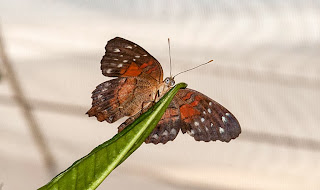If you’ve visited Pacific Science Center in the past two weeks, you may have wondered why the rest of the exhibits are open but our Tropical Butterfly House remained closed.
Perhaps you’ve peeked in the window and spotted a big orange lift, wheeling slowly around the pathways. The lift is big enough to completely block the path. It’s almost exactly the same size as our exit vestibule, and every available Life Sciences person helped out one morning to help it steer its way in without letting a single butterfly escape. The lift was heavy enough to endanger the floor, so driving it meant preparing the way by placing plywood sheets under the front wheels. Of course it also meant we had to watch out below – staff and volunteers let the lift work on one side of the house, while we groomed and watered plants on the far end, away from any danger.
Normally members of the Life Sciences department operate the lift to change the light bulbs, but this year is different. We are not just swapping out one light bulb for another, but switching to lower energy bulbs. This means not only replacing our old enormous bulbs with new slightly smaller ones but also removing all the ballasts and installing a new starter for each lamp. We worked with an outside contractor for this quite involved process. These smaller HID lamps will save us 25% of our energy bill!
Unfortunately, greater energy saving LED lights would not provide the spectrum of light we needed to keep the butterflies flying. We will continue to save a bit more energy by having the lights programmed to turn off during days when the sunshine outdoors is bright enough to grow the plants and stimulate the butterflies into flying. In Seattle, those days are nearing an end for the year, as we move into dark weather.
Lighting is the big news in the butterfly house, but it’s far from the only story.
Several of our largest plants threatened to grow up to the ceiling. We reduced them in size – sometimes quite drastically, cutting back to the scaffold of trunk and main branches, and letting new growth fill in where the old growth had become skinny and unhealthy. With other plants, patient volunteers sorted through overgrown stems, snipping out the tired ones and leaving the healthiest and strongest.
We fertilized, removed spent flowers, and gave all the trees a good shake to remove any dead leaves. All of this is important for plants in a conservatory setting. Far from doing harm, cutting back plants stimulates new growth.
After all the shaking, cutting, feeding and digging, we had very dirty floors. Our next job was to pressure wash, rinsing away the muddy, leafy, ground in grime from so much good work being done.
Knowing we were going to be closed for much of September, we stopped purchasing new butterflies in late August. But even as the month went on, a few hardy fliers remained. We enjoyed their company as we worked on our various projects.
Now the surviving butterflies are joined with a new shipment, so we should have plenty of them in time to reopen, along with dazzling lights and healthy, floriferous plants.
Come in and enjoy! The Tropical Butterfly House reopens October 5.
Wednesday, October 2, 2013
Subscribe to:
Post Comments (Atom)









No comments:
Post a Comment